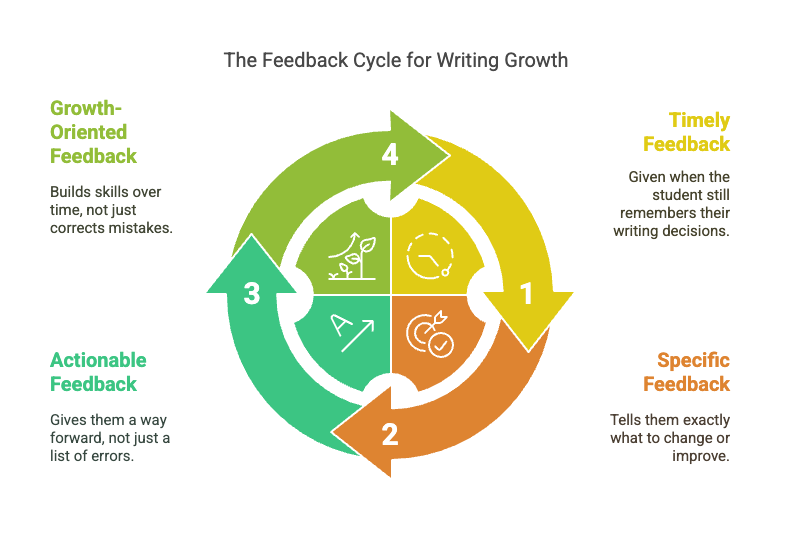The Role of Feedback in Writing Development
Feedback is the engine that powers writing growth.
But not all feedback is equal. To be effective, it must be:
✔️ Timely
Given when the student still remembers their writing decisions.
✔️ Specific
Tell them exactly what to change or improve.
✔️ Actionable
Gives them a way forward, not just a list of errors.
✔️ Growth-Oriented
Builds skills over time, not just corrects mistakes.Without this, students either:
- Feel lost ("I don’t know why it’s wrong")
- Or stuck ("I don’t know how to fix it")

💬 Analogy:
Imagine telling a soccer player, “You missed the goal,” without saying how to aim better or what technique to try. That’s how generic feedback feels in writing.
Research is clear
Effective feedback is one of the most powerful influences on student achievement in writing—when done well (Hattie & Timperley, 2007). In writing instruction, feedback must move beyond error correction to become a formative learning tool that guides students toward independence and growth.
✔️ Timely Feedback
Writing feedback is most effective when delivered during or shortly after writing, while students still remember the reasoning behind their choices (Black & Wiliam, 1998). Delayed feedback can feel disconnected; immediate feedback supports metacognition and encourages revision (Bitchener & Ferris, 2012).
✔️ Specific Feedback
Vague comments like “be clearer” or “expand more” are difficult for learners to act upon. Instead, specific feedback identifies the issue and suggests how to improve it (Brookhart, 2008). For instance, “This paragraph needs a clearer topic sentence to guide the reader” is more instructive than “Unclear.”
✔️ Actionable Feedback
Good feedback includes forward-facing guidance, not just a list of what went wrong. According to Sadler (1989), students must understand: (1) the criteria for good work, (2) how their work compares, and (3) what they can do to close the gap. This is critical in scaffolding student self-regulation.
✔️ Growth-Oriented Feedback
Feedback should build writing identity and skills over time—not just fix surface-level errors. Effective teachers use feedback to reinforce writing strategies, genre awareness, and self-assessment habits (Graham & Harris, 2005).
Digital tools like Scribo operationalize these principles at scale, providing real-time, specific, and growth-oriented feedback. This helps shift writing from a “mark-and-move-on” task to a continuous cycle of learning and improvement.
✨ How Scribo Helps:
Scribo gives:
- Live feedback while students write (catching issues in real time)
- Post-writing improvement tasks (so students reflect and revise)
- Visuals and heatmaps of writing strengths and weaknesses (for both student and teacher insight)
So it’s not just correction—it’s coaching.
❓ Socratic Questions:
- What’s the most effective feedback you’ve ever given a student? Why do you think it worked?
- Have you ever seen a student improve quickly because of well-timed, actionable feedback?
📝 Quick Task:
Think of a piece of writing your students commonly struggle with (e.g., introductions, topic sentences, idea development).
Now imagine you had Scribo giving them just-in-time tips for that part.
What kind of feedback would you want Scribo to give? Write a sample.
There are no comments for now.